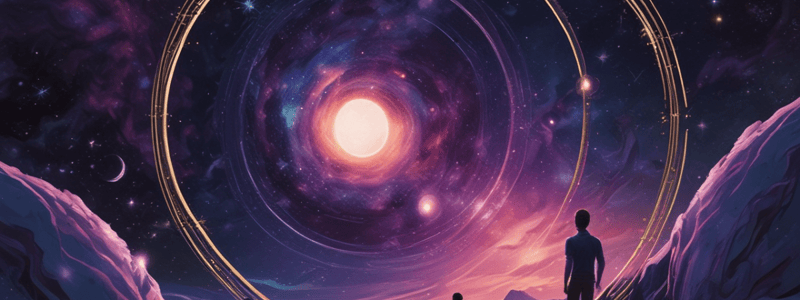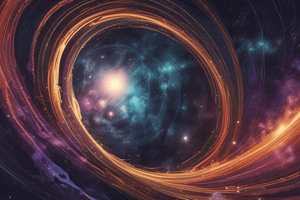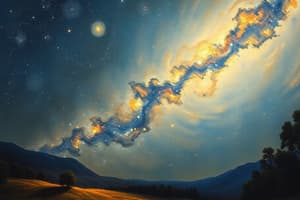Podcast
Questions and Answers
What holds galaxies together?
What holds galaxies together?
- Electromagnetism
- Magnetism
- Friction
- Gravity (correct)
How many galaxies are estimated to exist in our observable universe?
How many galaxies are estimated to exist in our observable universe?
- A couple hundred billion (correct)
- Over a trillion
- About a million
- Less than a thousand
What is the name of the closest galaxy to the Milky Way?
What is the name of the closest galaxy to the Milky Way?
- The Sombrero Galaxy
- The Pinwheel Galaxy
- The Andromeda Galaxy (correct)
- The Triangulum Galaxy
What is unique about each star in a galaxy?
What is unique about each star in a galaxy?
Why was the word 'galaxy' derived from the Greek word 'galaxias'?
Why was the word 'galaxy' derived from the Greek word 'galaxias'?
What is the shape of the Milky Way galaxy?
What is the shape of the Milky Way galaxy?
What can be found at the center of a galaxy?
What can be found at the center of a galaxy?
What is the name of the supercluster that our galaxy is a part of?
What is the name of the supercluster that our galaxy is a part of?
What type of stars can be found in the central bulge of a galaxy?
What type of stars can be found in the central bulge of a galaxy?
Where can open clusters of young, hot, and bright stars be found in the Milky Way?
Where can open clusters of young, hot, and bright stars be found in the Milky Way?
Which type of galaxy is believed to have the Milky Way?
Which type of galaxy is believed to have the Milky Way?
What distinguishes barred spiral galaxies from normal spiral galaxies?
What distinguishes barred spiral galaxies from normal spiral galaxies?
Which type of galaxy is described as neither disk-like nor elliptical but appears as a blob of stars?
Which type of galaxy is described as neither disk-like nor elliptical but appears as a blob of stars?
What is a characteristic of giant elliptical galaxies?
What is a characteristic of giant elliptical galaxies?
How are spiral galaxies typically described in terms of color and structure?
How are spiral galaxies typically described in terms of color and structure?
Flashcards are hidden until you start studying
Study Notes
What is a Galaxy?
- A galaxy is an enormous collection of stars, gas, dust, and dark matter held together by gravity.
- Galaxies can exist alone or in clusters, scattered throughout the universe.
- Galaxies are born, mature, and eventually die.
- Each galaxy can contain trillions of stars, each with its own unique solar system.
Characteristics of Galaxies
- There are approximately 200 billion galaxies in our observable universe.
- Our galaxy is called the Milky Way, and the closest galaxy to us is the Andromeda galaxy, approximately 2 million light-years away.
- The Andromeda galaxy is our closest extragalactic neighbor and is visible with the naked eye.
Galactic Structure
- The Milky Way is a spiral galaxy, with our solar system located within one of its four spiral arms.
- The galaxy is structured in ordered groups of gas, dust, old stars, young stars, and a black hole.
- Clusters of stars within the galaxy contain older or younger stars, indicating the age and formation of the galaxy.
Components of a Galaxy
- The disk component is where most star formation occurs and is rich in gas, dust, and stars.
- The spherical component consists of the halo and central bulge, with old stars and no new star formation.
- The central bulge is populated with old, metal-poor stars, while the halo is a spherical cloud of stars and star clusters.
Types of Galaxies
- There are three main types of galaxies: elliptical, spiral, and irregular.
- Elliptical galaxies are either circular or elongated, contain older stars, and have little gas and dust.
- Spiral galaxies are flat, disk-like, and contain stars, gas, and dust, with active star formation.
- Irregular galaxies are neither disk-like nor elliptical, have little dust, and are rarely found in the universe.
Studying That Suits You
Use AI to generate personalized quizzes and flashcards to suit your learning preferences.




